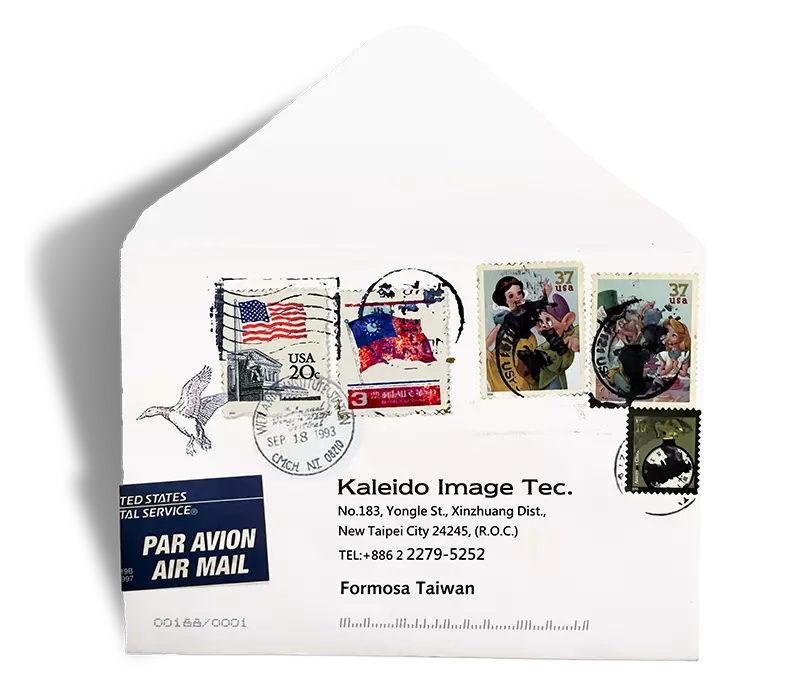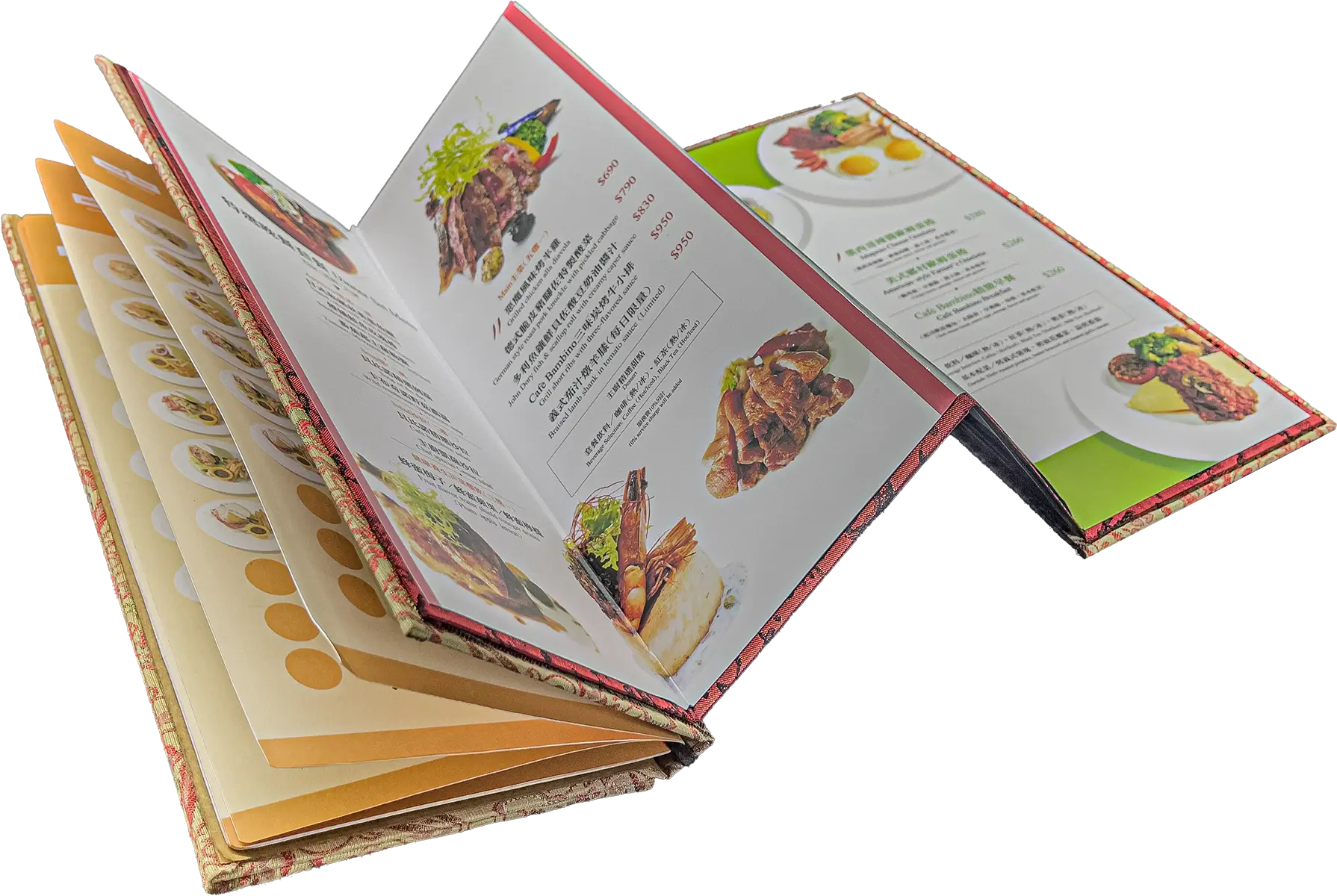
Functional Cloth N-Series MEMU Details
The legendary N-Type Folding Case, commonly known as “Hand-Folded Book” in the market, and officially referred to as “Memorial to the Throne.
This Hand-Folded Menu Book was created by the founder of this establishment during their apprenticeship between 1986 and 1990. Due to its intricate craftsmanship, it has yet to be officially promoted for widespread use. However, in 2025, a buyer inquired about it, prompting the use of an iPhone to photograph it for reference.
The Hand-Folded Menu Book, properly referred to as “Hand-Folded Book”, derives its name from its distinctive N-shaped folding method. It is also known by various other names, such as Spring Fold, Guanyin Fold, Double Fold, Wrap Fold, and Tri-Fold, among others. These alternative names stem from different characteristics of the Hand-Folded Book. While these terms are not widely recognized in professional terminology, they have become deeply ingrained in common usage and are widely understood by the public.
The number of pages in a Hand-Folded Book increases exponentially based on the number of folds. The more pages it has, the more complex the folding process becomes. Therefore, it is generally recommended that each Hand-Folded Book contain 6 to 8 pages for optimal practicality.
Formosa Taiwan

The third letter of "MENU" is N.
N + U-Type Menu Case equipped with a multiple-of-four inner page series and large full-color adhesive prints.

The N-Type Menu Bookbinding features a unique structure, which imposes certain limitations on the selection of inner pages. However, it can be adjusted based on a restaurant’s needs and budget. Below are some common inner page options:
- Art Paper Inner Pages: Dreamlike and high-quality, art paper provides a luxurious feel, making it ideal for exquisitely designed menus that require a sophisticated touch.
- Ivory Paper Full-Color Inner Pages: Printed using 180gsm ivory paper with digital inkjet printing, these pages can be laminated with either a glossy or matte finish, increasing the thickness to approximately 220gsm after lamination.
Additionally, we have redesigned and improved the N-Type Folding Case, making it compatible with all types of inner page binding. This enhancement removes the previous limitation of relying solely on folding techniques.
Our menu book designs focus on a core sustainability concept, rigorously selecting materials that have been SGS-certified. We offer over 1,000 material choices, with potential durability of over 10 years. Each menu book also comes with a 1-year quality warranty.
- Material:
3D Embroidered Fabric, dual-color combination of the same material - Processing: None
- Binding:
Flat Cord + Full-Color Large Graphic Adhesive Print - Inner Pages:
Multiples-of-Four Inner Page Series
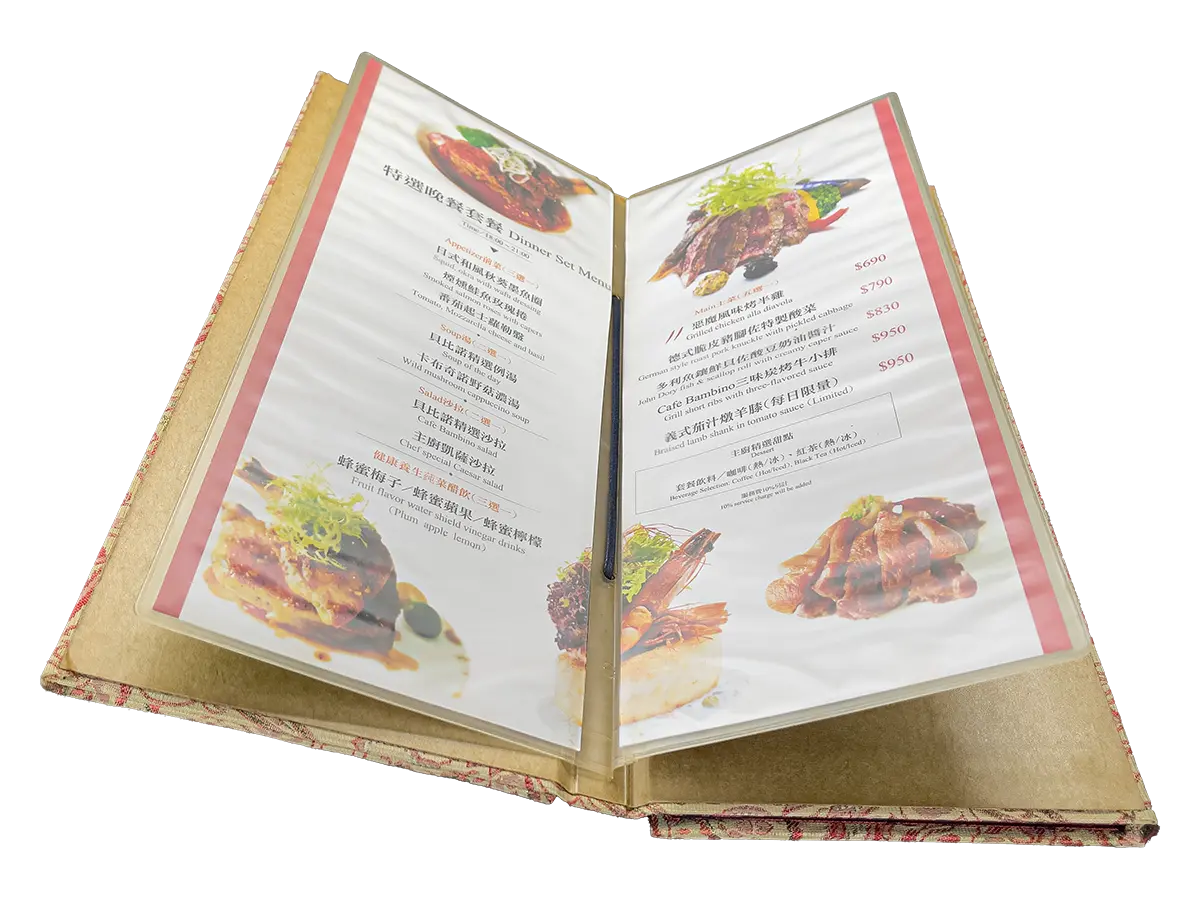
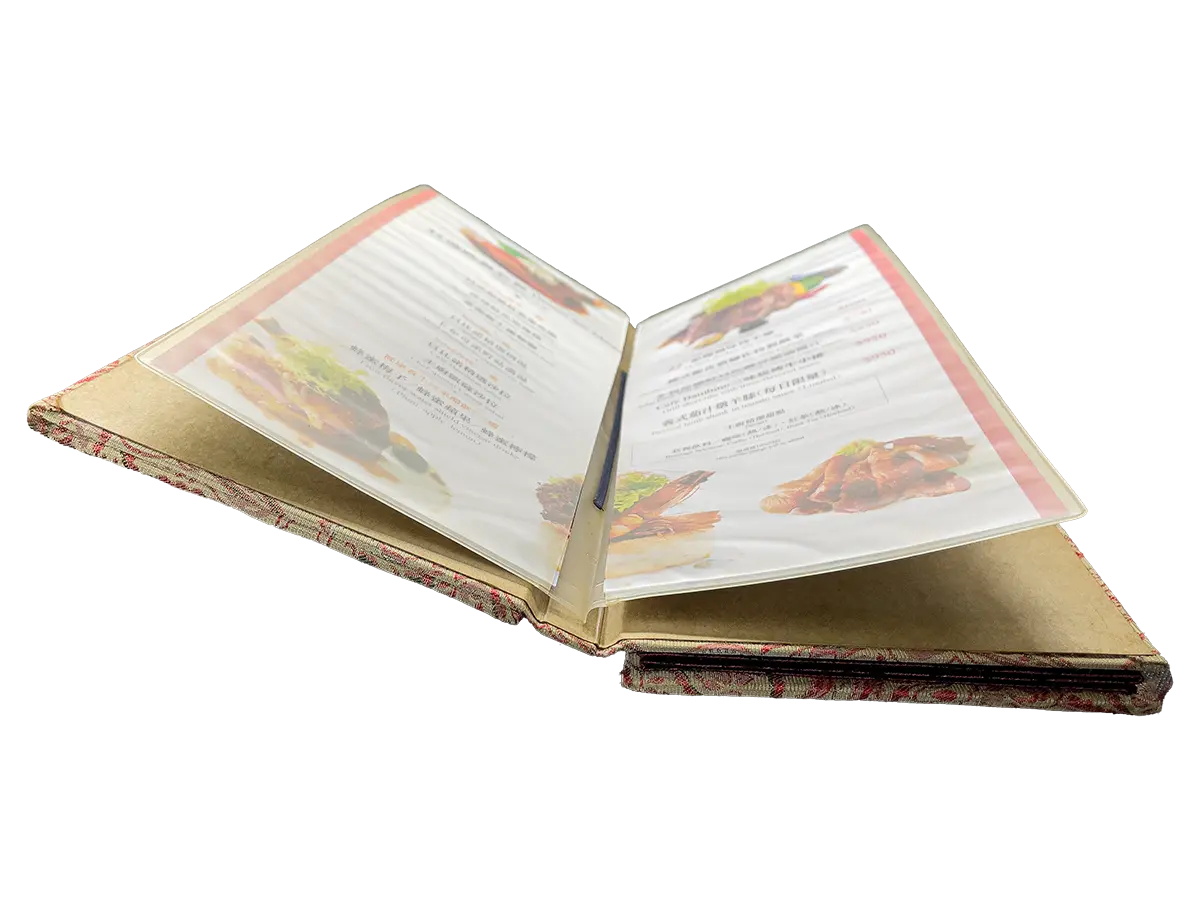
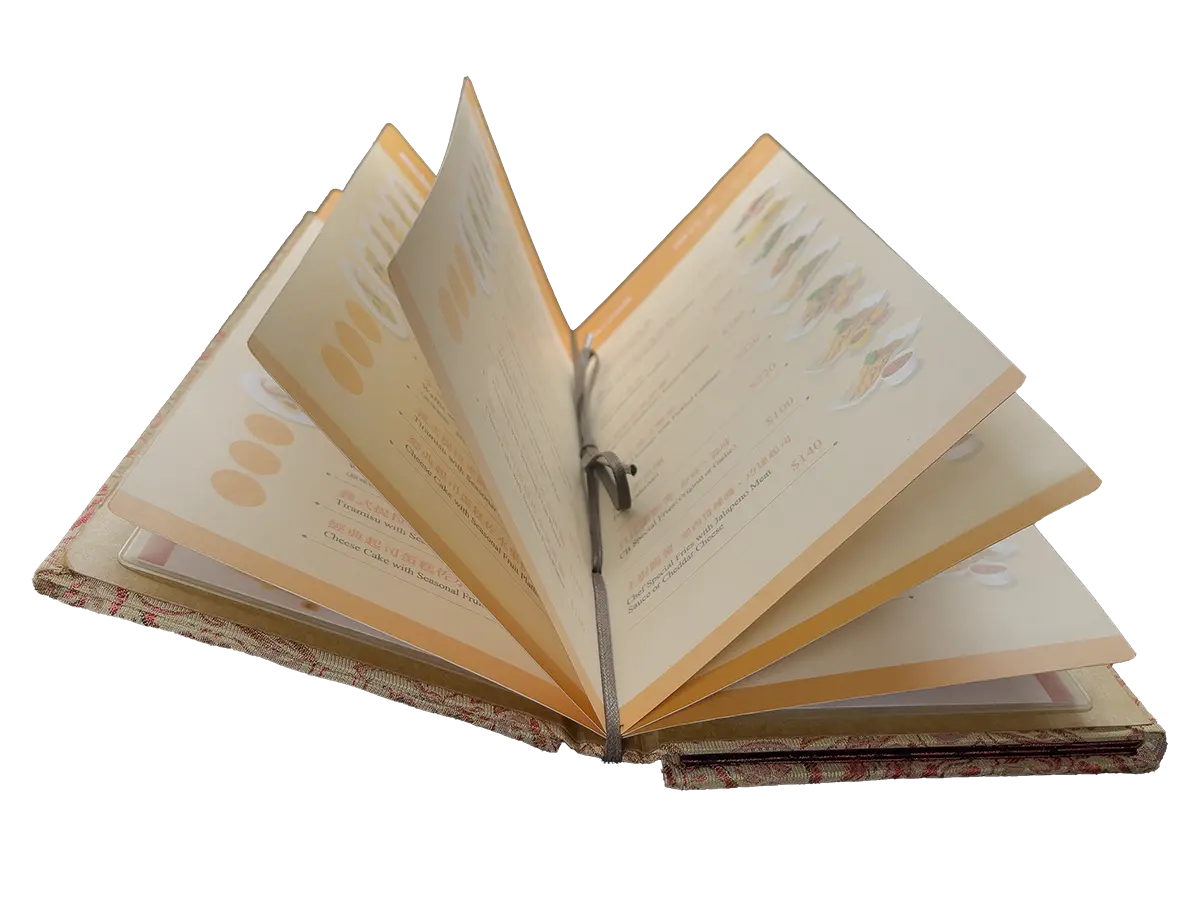
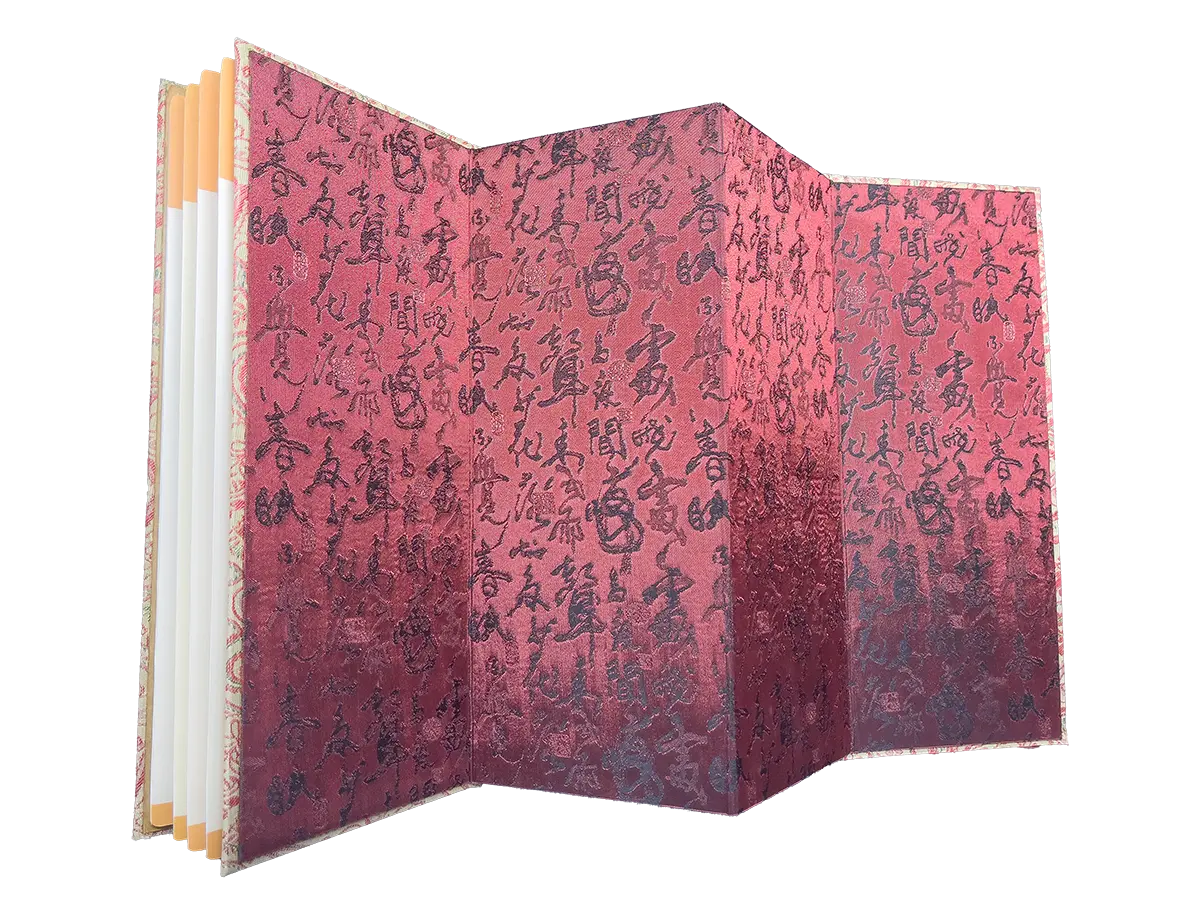

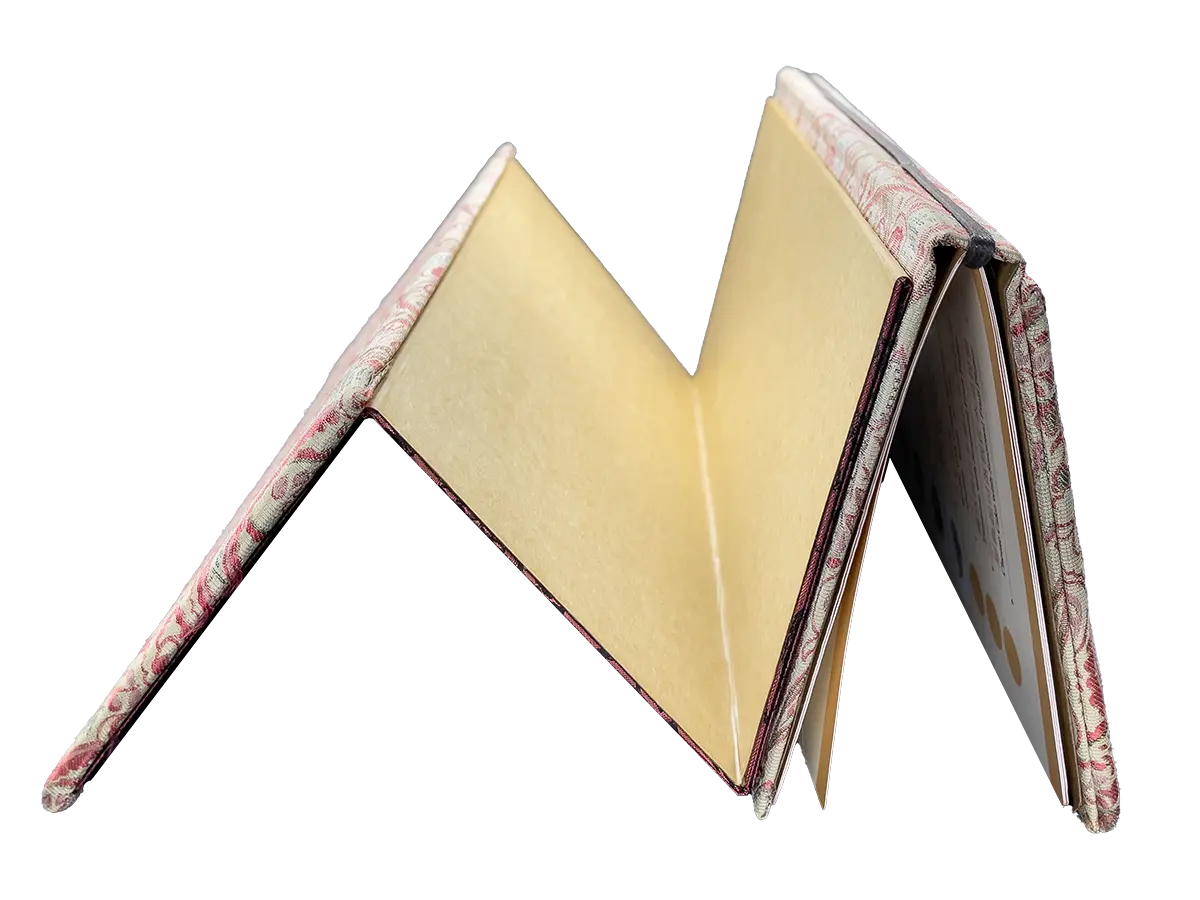
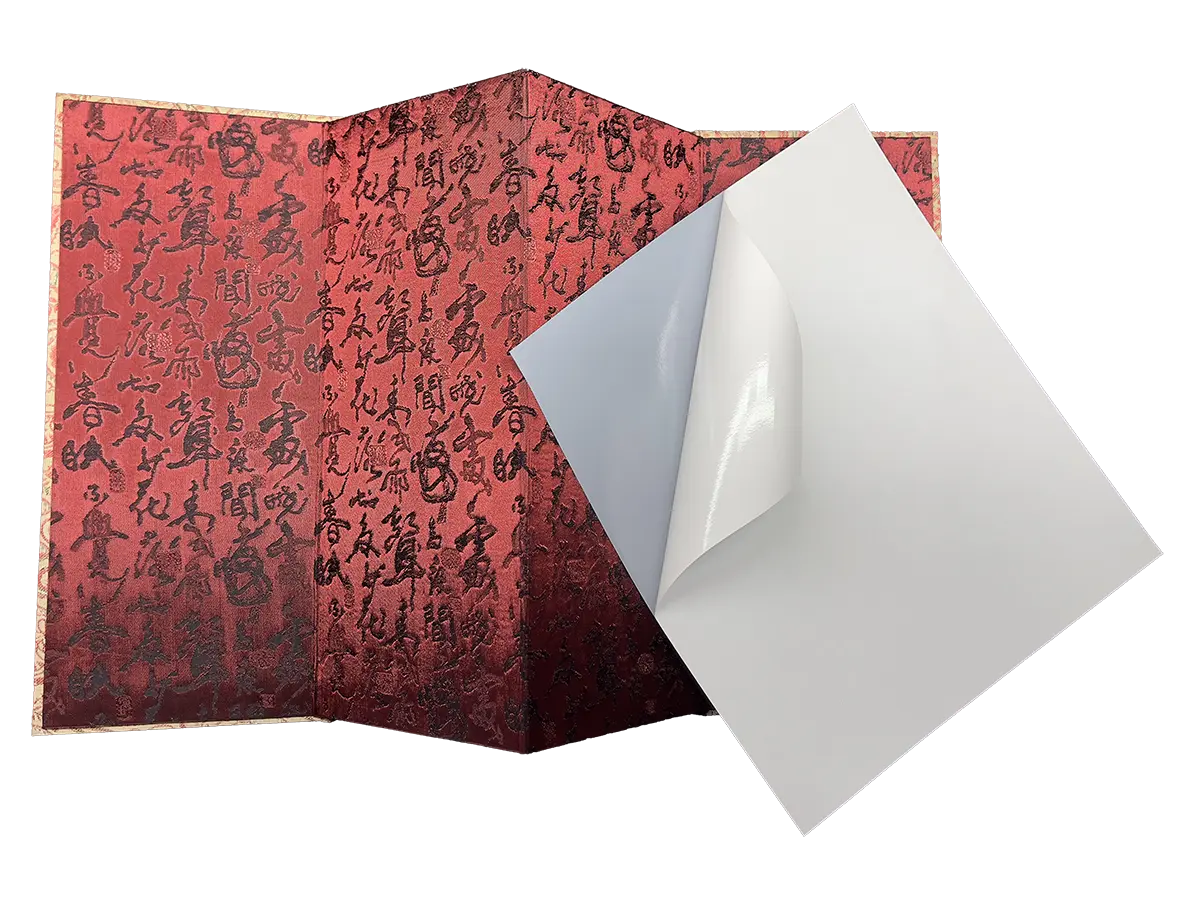
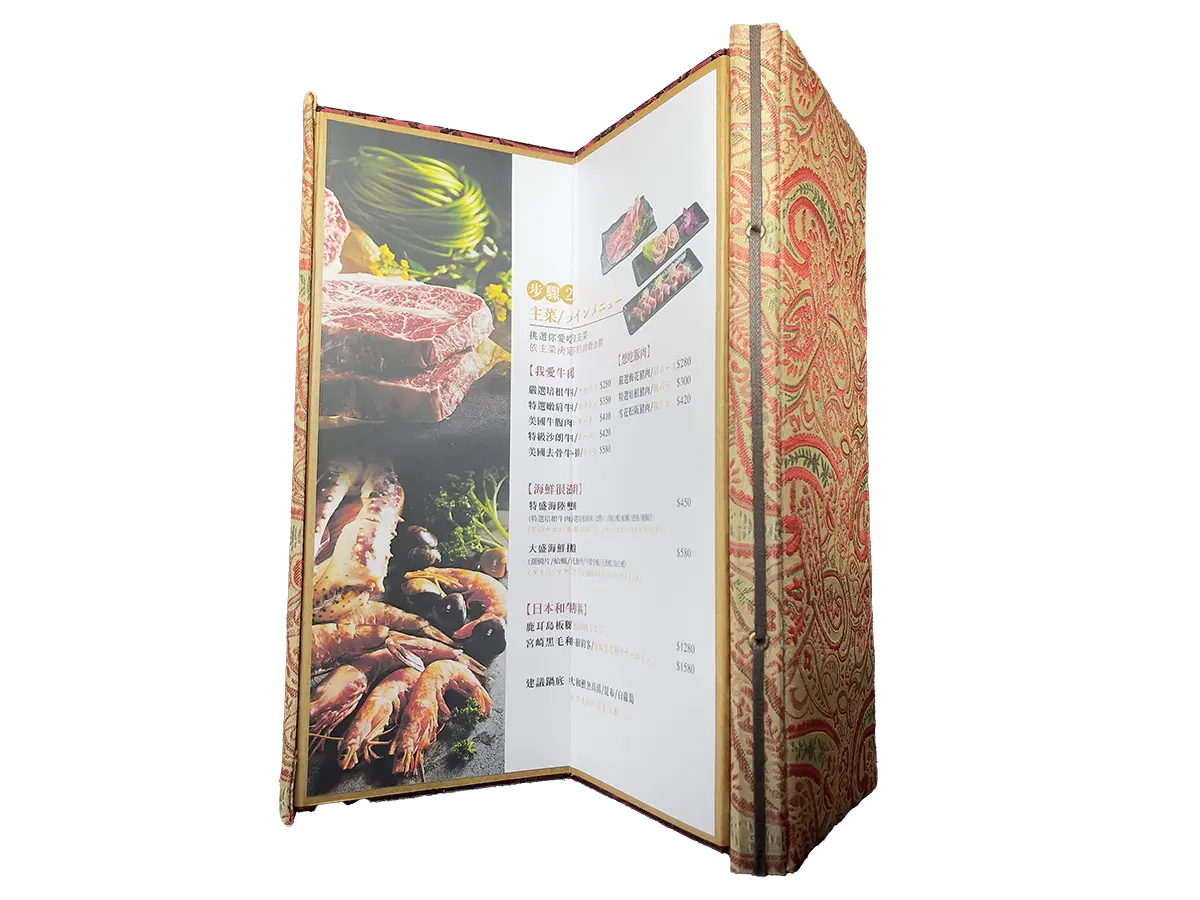
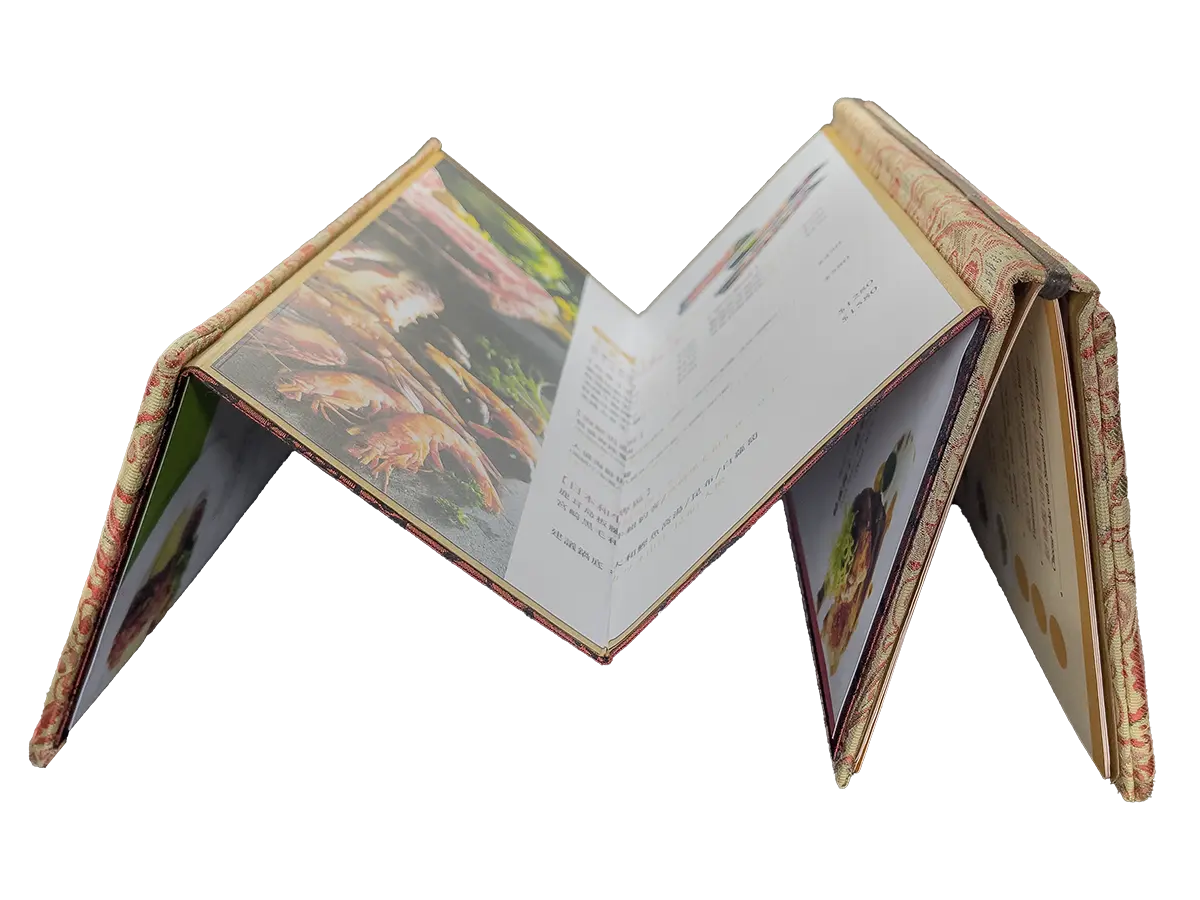
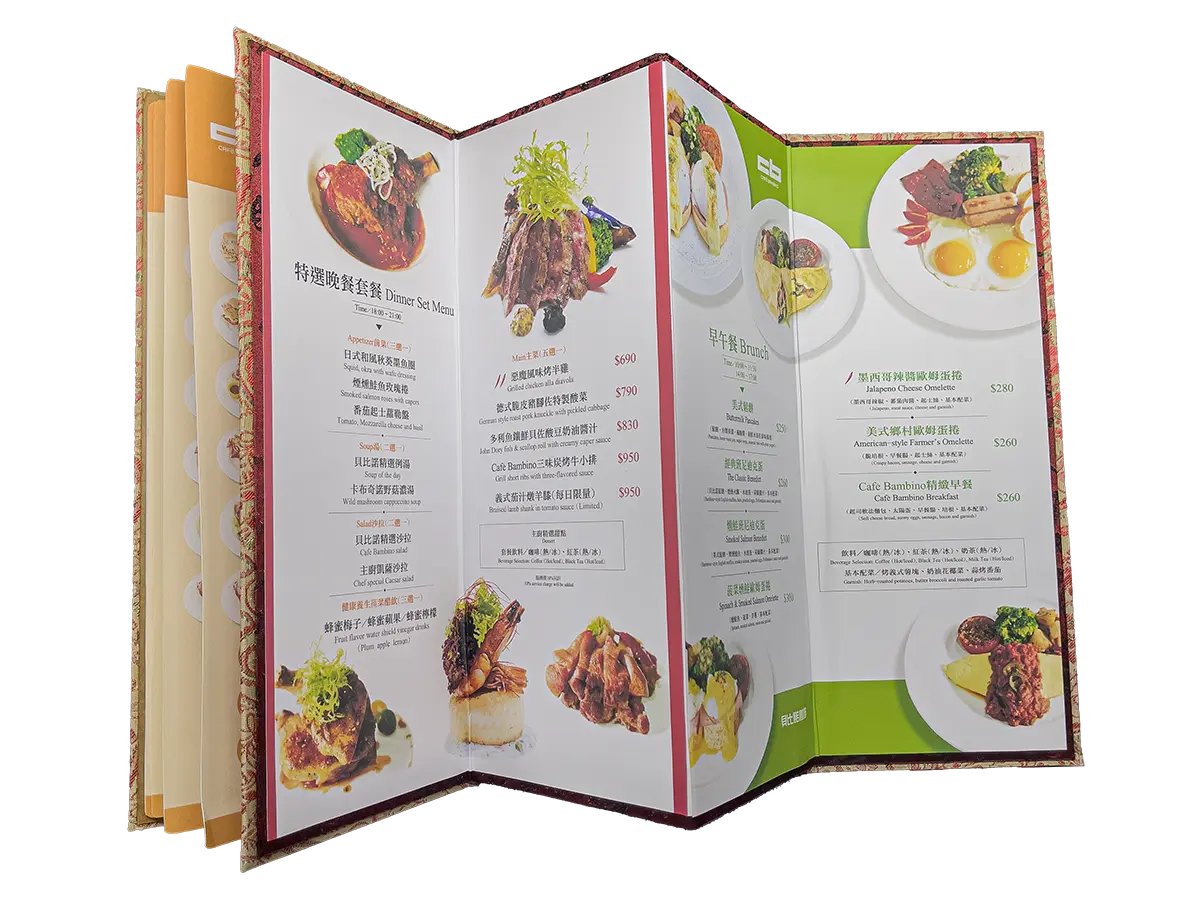
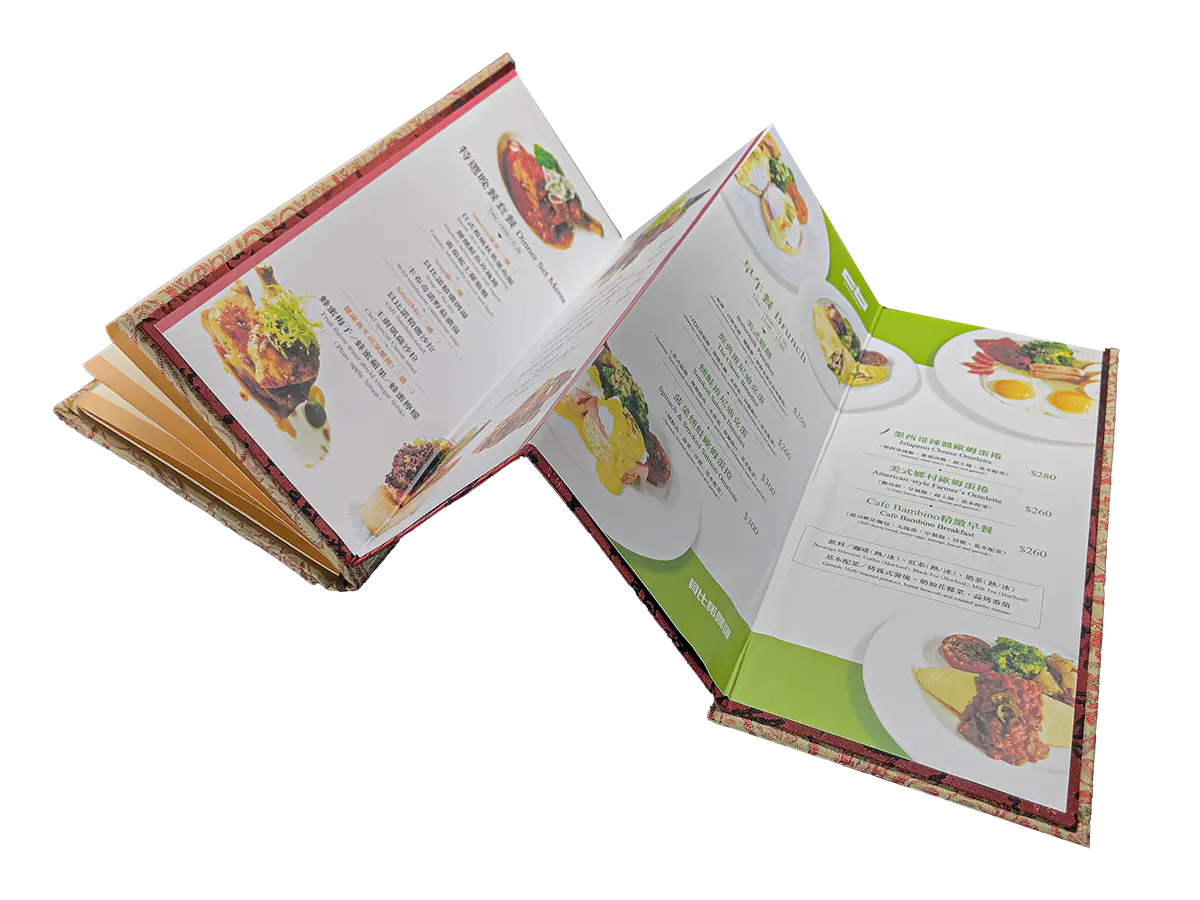
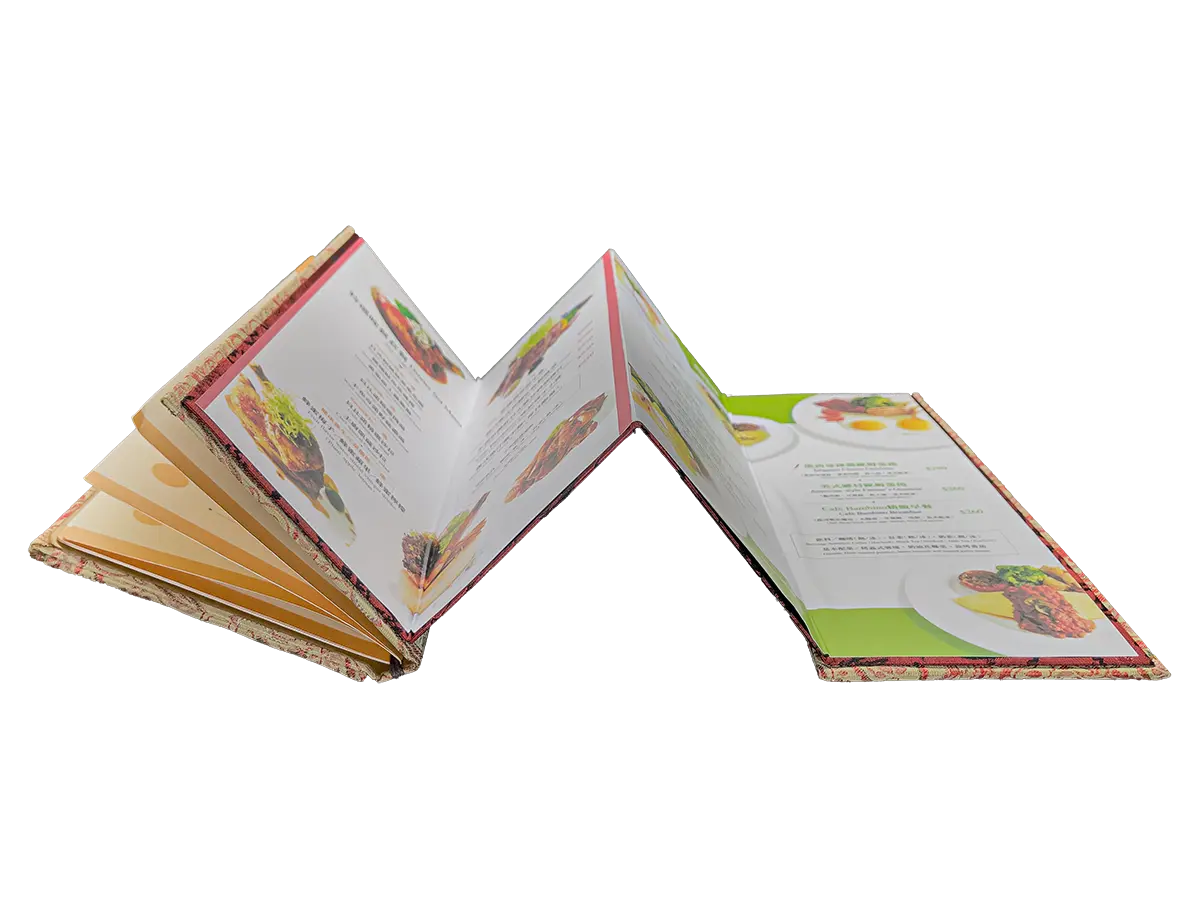
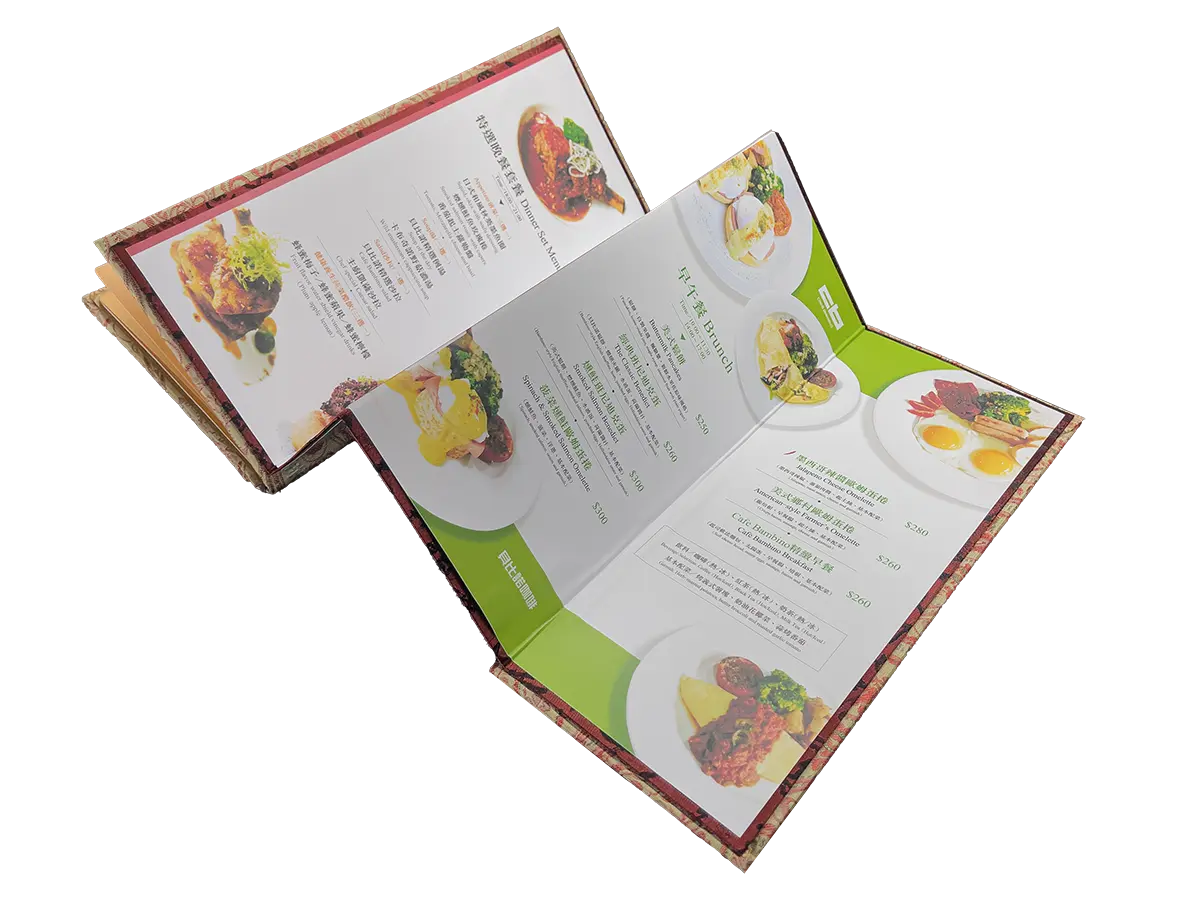

I understand that this might be a bit complex, so I’ve uploaded all the captured images to illustrate it clearly. If a regular book is considered as “1”, then the N-Type Menu Book I created is a “3”, showcasing its complexity. While this level of craftsmanship may seem somewhat impractical, the visual impact is undeniably stunning.
For the large-format printing, we use gray adhesive materials for several reasons:
- Full Coverage – It effectively covers and presses over the base color, preventing color transparency issues.
- Residue-Free & Reusable – The adhesive leaves no residue, allowing it to be reapplied multiple times.
This feature helps protect the N-Type Menu Book from damage and extends its lifespan.
The inner pages follow a multiples-of-four binding system, making it compatible with various multiples-of-four page formats, including:
- Plastic Sleeve Inner Pages
- Invincible Menu Inner Pages
- American-Style Menu Inner Pages
- Ivory Paper Inner Pages
These formats can be directly applied to the N-Type Menu Book without additional modifications.
The History and Evolution of the Hand-Folded Menu Book
The emergence of folded menu booklets did not originate in the Ming and Qing dynasties; rather, their history is long and far predates existing historical records. Due to the difficulty of preserving artifacts, many early cultural heritage items related to food culture have been lost, making the records we see today only a fraction of what once existed. However, from a historical perspective, the concept of folded booklets has been present across different stages of human civilization.
Before paper became widespread or was even invented, ancient people used locally available materials to create various forms of folding tools. For instance, bamboo slips, wooden tablets, stone slabs, tortoise shells, animal bones, and leaves were used as writing mediums, bound together with ropes, leather, or other materials to form booklets with an “N”-shaped folding structure. This folding method not only facilitated portability and preservation but also enhanced readability, leading to its broad application in various fields.
At the official level, this type of folding document evolved into the “memorials to the throne” (奏摺), which were widely used within and outside the imperial court. As an essential tool for officials during the Ming and Qing dynasties to report political affairs directly to the emperor, these memorials carried a high level of confidentiality and immediacy, marking the formal application and development of the folding writing system in government affairs. Meanwhile, similar folded booklets also emerged among the general public for recording business transactions, literary compositions, and even menu creation, serving as an important testament to early culinary culture.
In the culinary field, the birth of folded menu booklets was closely linked to the flourishing of ancient food culture. Large banquets or restaurant operators in early times adopted the folded format for menus to facilitate recording and presenting dishes to guests. This method made the ordering process more organized and enhanced the overall dining experience. These menus were often crafted with exquisite workmanship, with some featuring carved inscriptions on bamboo or wooden slips, while others were written with brushes on silk, reflecting the aesthetic styles of different eras and regions.
With the advancement of paper-making techniques and the popularization of printing, paper-based menus gradually replaced the earlier bamboo and wooden folding booklets, becoming an essential element of the modern restaurant industry. However, the form and essence of folded menus continue to influence modern menu design. Even today, in high-end restaurants or vintage-style establishments, one can still find menus that imitate ancient folding formats, blending traditional and contemporary cultural elements.
The history of folded menu booklets is not only a microcosm of the evolution of food culture but also a reflection of ancient wisdom. These menus carry more than just the names of dishes—they encapsulate rich historical memories and cultural heritage.
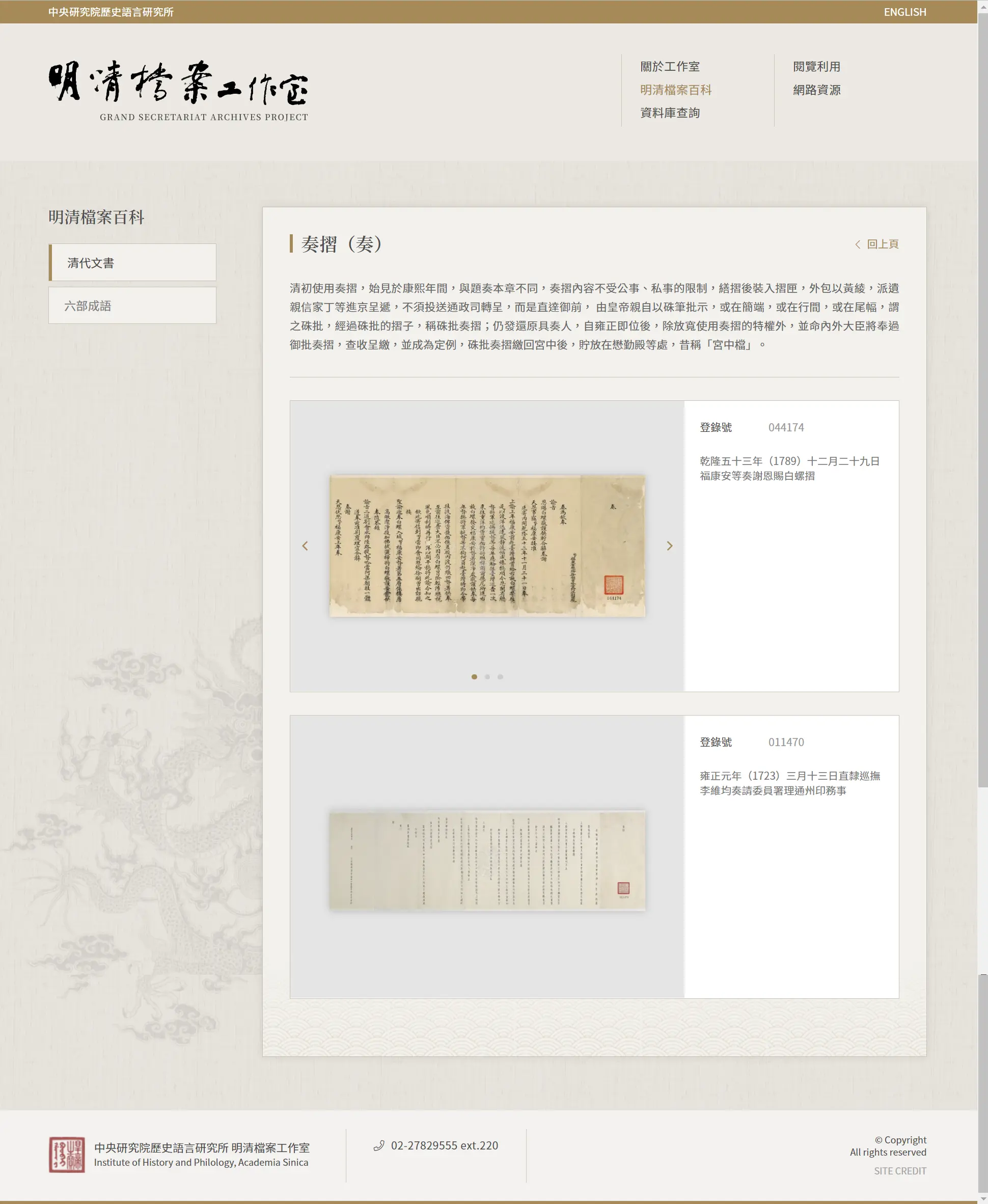
A claim was once published on a well-known encyclopedia website stating that folded booklets originated in ancient China and were used as sheepskin passports for ambassadors. However, this theory contained internal contradictions and lacked solid evidence, leading to its quick scrutiny and eventual removal. The format and purpose of folded booklets and sheepskin passports are distinctly different, and both historical records and theatrical depictions suggest that they served separate functions, making the claim of their Chinese origin unconvincing.
In contrast, the imperial edict folding memorial (聖旨奉摺) was an official document in the form of a folded booklet, used exclusively for governmental purposes. Folded booklets, however, were a widely popular folding method among the general public. Based on this fact, it is overly simplistic to conclude that they originated in China.
This establishment proposes a new perspective: historical records such as maritime exploration logs suggest that folded booklets were used to present large maps in a foldable format. This example indicates that folded booklets had become common portable items, widely applied in fields such as cartography. However, their exact origin remains difficult to trace.
References:奏摺明清檔案工作室
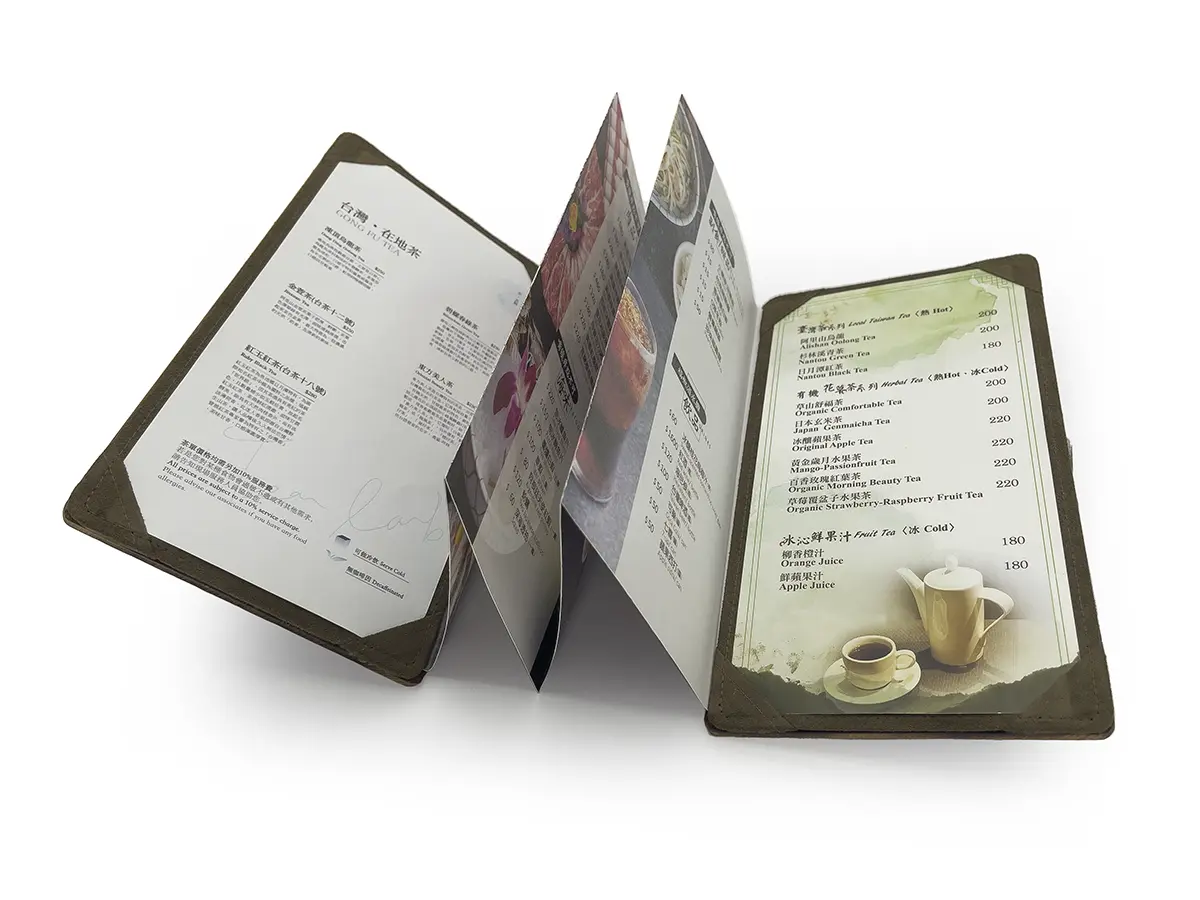
The N-shaped menu binding has a unique structure, and the selection of inner pages is subject to certain structural limitations. However, it can be adjusted based on the restaurant’s needs and budget. Below are some common options for inner pages:
Inner Page Options for N-Shaped Menus
- Art Paper Pages: Dreamy and high-quality art paper, perfect for menus that require an ultra-refined and exquisite design.
- vory Paper Color-Printed Pages: Printed using 180gsm ivory paper with digital inkjet printing. The surface can be coated with a glossy or matte film, increasing the thickness to approximately 220gsm after lamination.
Additionally, our establishment has introduced a newly improved N-shaped cover design, which now supports all types of page binding without being restricted to folding alone.
Our menu book design is centered around the core principle of sustainability, carefully selecting SGS-certified materials. We offer over 1,000 customization options, with a durability of up to 10 years and a 1-year quality warranty included.
Formosa Taiwan
The third letter of "MENU" is N.
N-Shaped Solid Wood Wine List Cover with Folded Booklet Inner Pages
Premium Wagyu Yakiniku Restaurant Hidden in the Alleys Near Yongchun MRT Station, Taipei
Nestled in the alleys near Yongchun MRT Station in Taipei, this high-end Wagyu yakiniku restaurant offers an exquisite dining experience.
Exclusive N-Shaped Wooden Wine List with Folded Booklet Inner Pages
The solid wood menu cover, paired with color-printed N-shaped folded booklet inner pages, is a masterpiece of craftsmanship. Constructed from natural wood with a suede-mixed interior lining, the cover is meticulously hand-brushed to achieve a charcoal-grilled textured finish.
Unlike traditional branding techniques, this menu features an improved logo embossing method that uses no open flames, no ash, and no smoke, creating a raised relief effect with natural color gradients. This process produces no CO₂ or PM2.5 emissions, relying solely on traditional artisanal techniques that surpass modern laser engraving, which lacks depth and dimension.
This exceptional menu is not just versatile but truly multifunctional, making it a rare find. To explore more about the story behind the folded booklet design, refer to the “N” link in the MENUs section at the top.
Material & Craftsmanship Details
- Material: Solid wood with a mixed suede-like synthetic fabric lining
- Processing: Traditional heat embossing technique, creating a naturally gradient color effect
Binding: Loose-leaf insert card system + N-shaped folded booklet inner pages - Inner Pages: High-quality art paper with color printing output
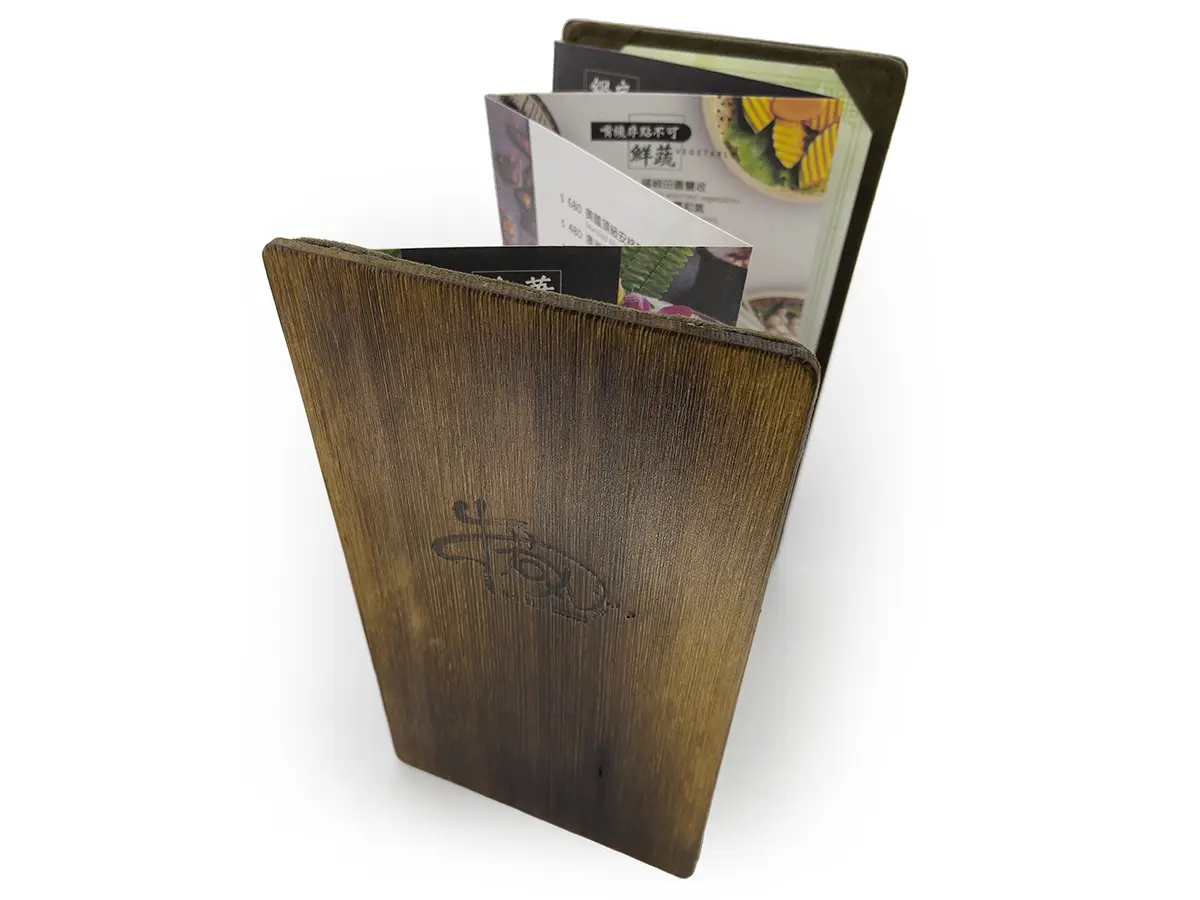
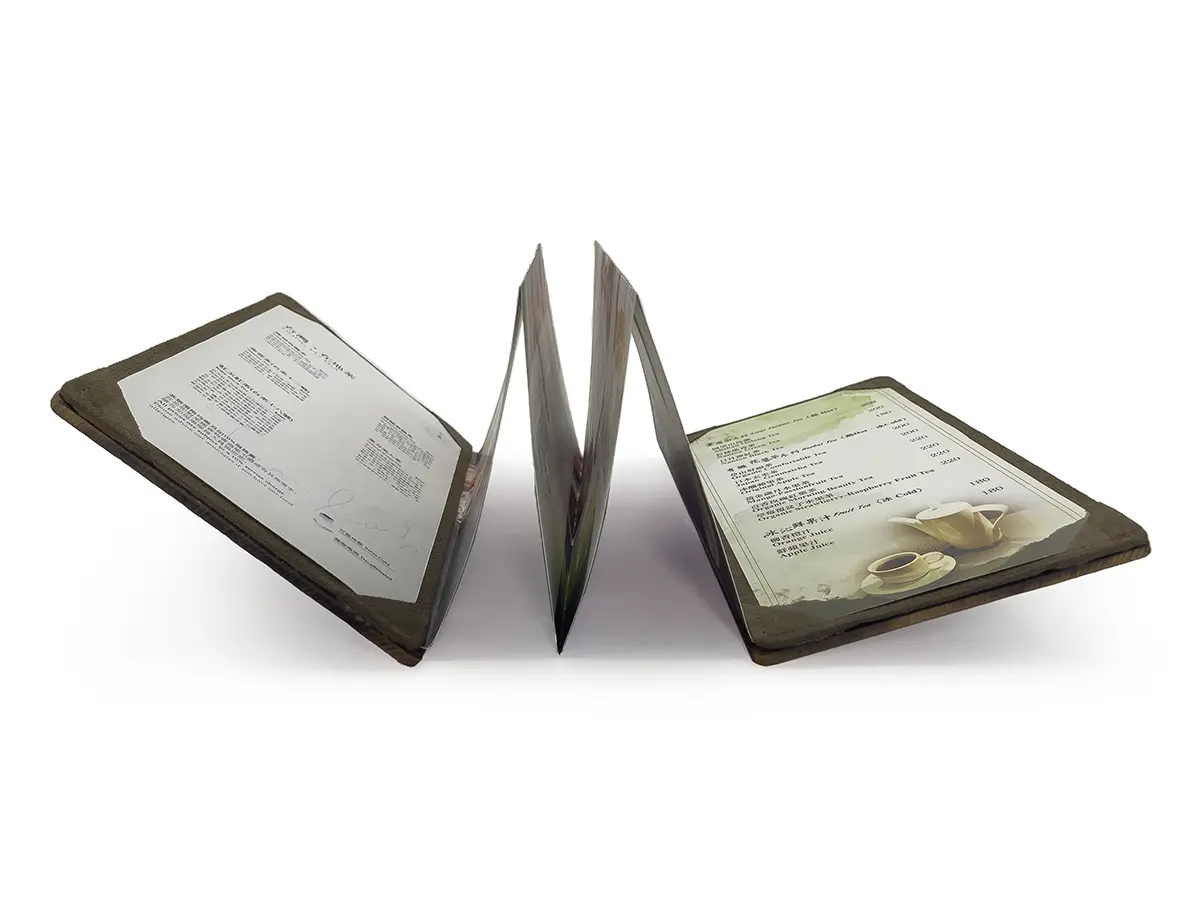

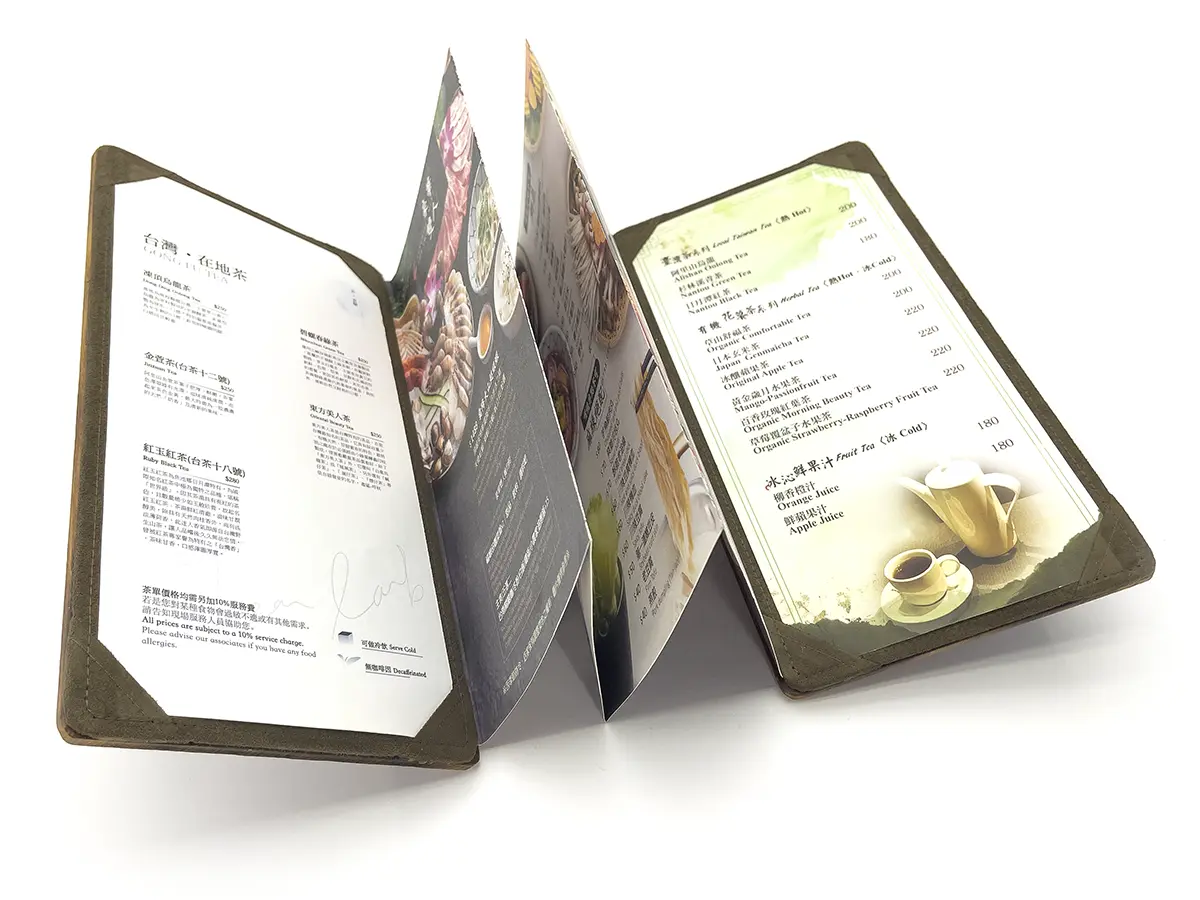
Our antique-style N-shaped folded booklet features color-printed inner pages with a quick-release, multi-purpose, and highly versatile design, making it an ideal choice for displaying large-format graphics with a striking visual impact.
References:F6
Material & Craftsmanship Details

這全系列的高效能聚酯纖維柔軟特殊Material & Craftsmanship Details機能布真是令人驚嘆,通過歐盟國家SGS驗證,無毒不含甲醛,給人安心又健康的使用體驗。不僅如此,這種材質還具備有超強防汙、100%防潑水的特性,讓使用者在潮濕、高溫、極劣環境下也能感到安心。而且,耐磨系數高達23000轉的測試結果更是令人驚豔,讓人放心地使用。此外,每種產品都採用SGS驗證合格的人造機能布,這份驗證真是非常重要,關係到使用者的身體健康。因為這種超耐磨防貓抓透氣人造機能布,不僅能使用更長久,還能有效地抑制黴菌,防範過敏,這全系列的高效能聚酯纖維柔軟特殊Material & Craftsmanship Details機能布真是令人驚嘆,通過歐盟國家SGS驗證,無毒不含甲醛,給人安心又健康的使用體驗。不僅如此,這種材質還具備有超強防汙、100%防潑水的特性,讓使用者在潮濕、高溫、極劣環境下也能感到安心。而且,耐磨系數高達23000轉的測試結果更是令人驚豔,讓人放心地使用。此外,每種產品都採用SGS驗證合格的人造機能布,這份驗證真是非常重要,關係到使用者的身體健康。因為這種超耐磨防貓抓透氣人造機能布,不僅能使用更長久,還能有效地抑制黴菌,防範過敏,100%防潑水,減少油耗味的生成。總之,這種材質真是令人讚不絕口,絕對是值得推薦的好產品。100%防潑水,減少油耗味的生成。總之,這種材質真是令人讚不絕口,絕對是值得推薦的好產品。

Functional Cloth Material color ranking recommendation

There are numerous colors available, but we cannot list them all. Due to differences in display color, the actual product may differ slightly from the photo. For more information, please refer to our material book.
A sustainable menu book with a lifespan of up to 10 years can be achieved with attentive management. You don’t have to worry about the durability of the menu book. Our unique technology also allows the menu book to have a pleasant aroma, and regular cleaning can effectively prevent bacterial growth and eliminate odors. Our product is SGS certified, preventing mold and toxins from entering the mouths of our customers, ensuring you can enjoy your food with peace of mind.
客房菜單
Our custom menus are one-of-a-kind and can be tailored to the buyer’s preferences. For room service menus, we intentionally make them thick and sturdy to prevent them from being taken away, but we can also make them small and thin based on the buyer’s needs. The materials used for the inside and outside of the menu can be mixed and matched to provide a wide range of options. We recommend using a four-hole metal clip for quick and easy replacement of the pages during events.
We support a variety of fine art papers for the inner pages.
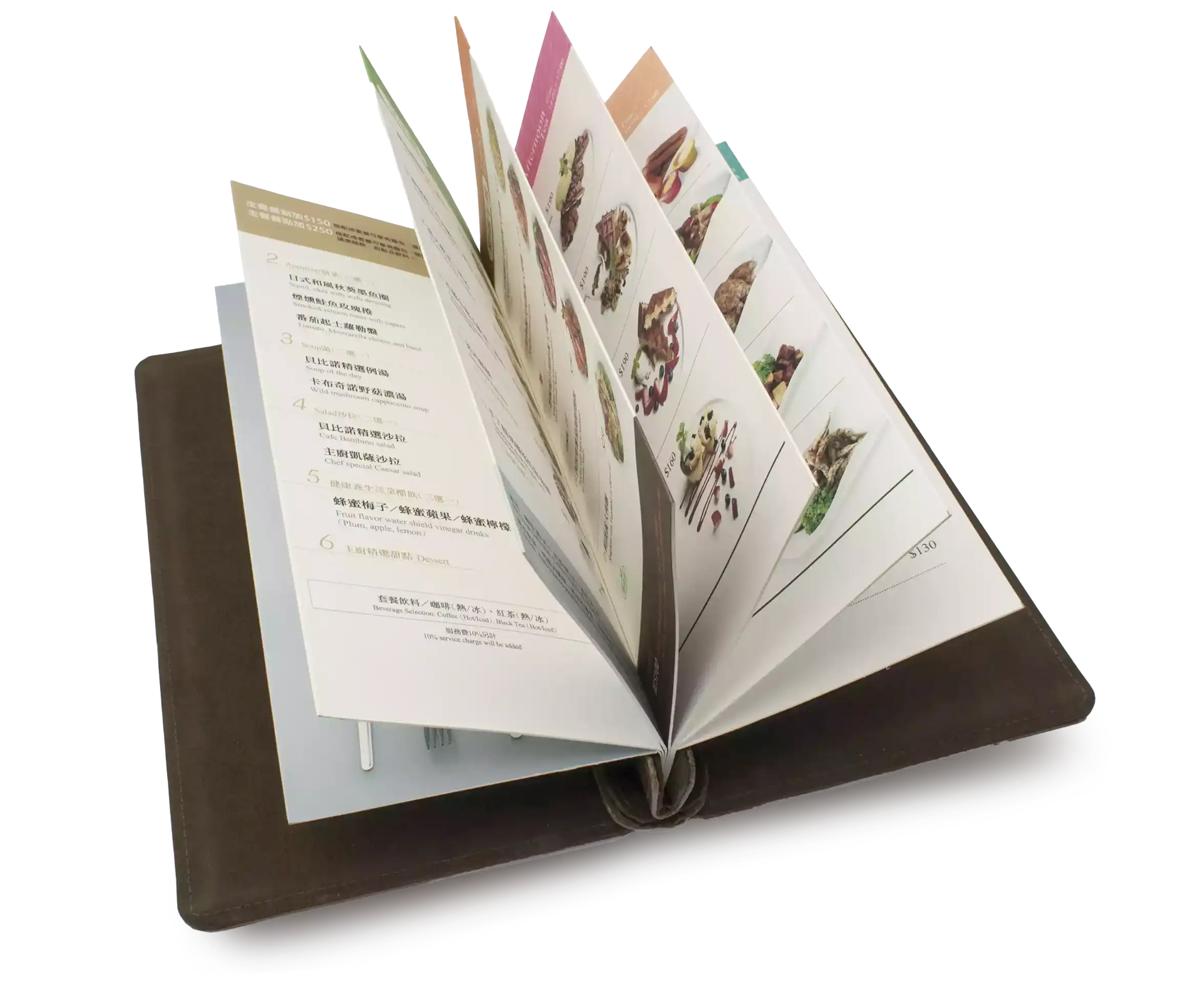
The inner pages of this design utilize our proprietary technology, which includes cardboard pages, and is one of our recommended options. The entire series features pages that can be easily added, removed, or replaced, and we support the purchase of various types of fine art paper, waterproof paper, cardboard pages, and magazine paper for the inner pages. If you prefer not to use PVC materials, the aforementioned materials can be purchased separately for use as inner pages. However, only our shop’s products feature inner pages that are easy to flip, durable, without rebounding, and without cracking or splitting along the spine. For estimated production time and costs, please feel free to inquire.
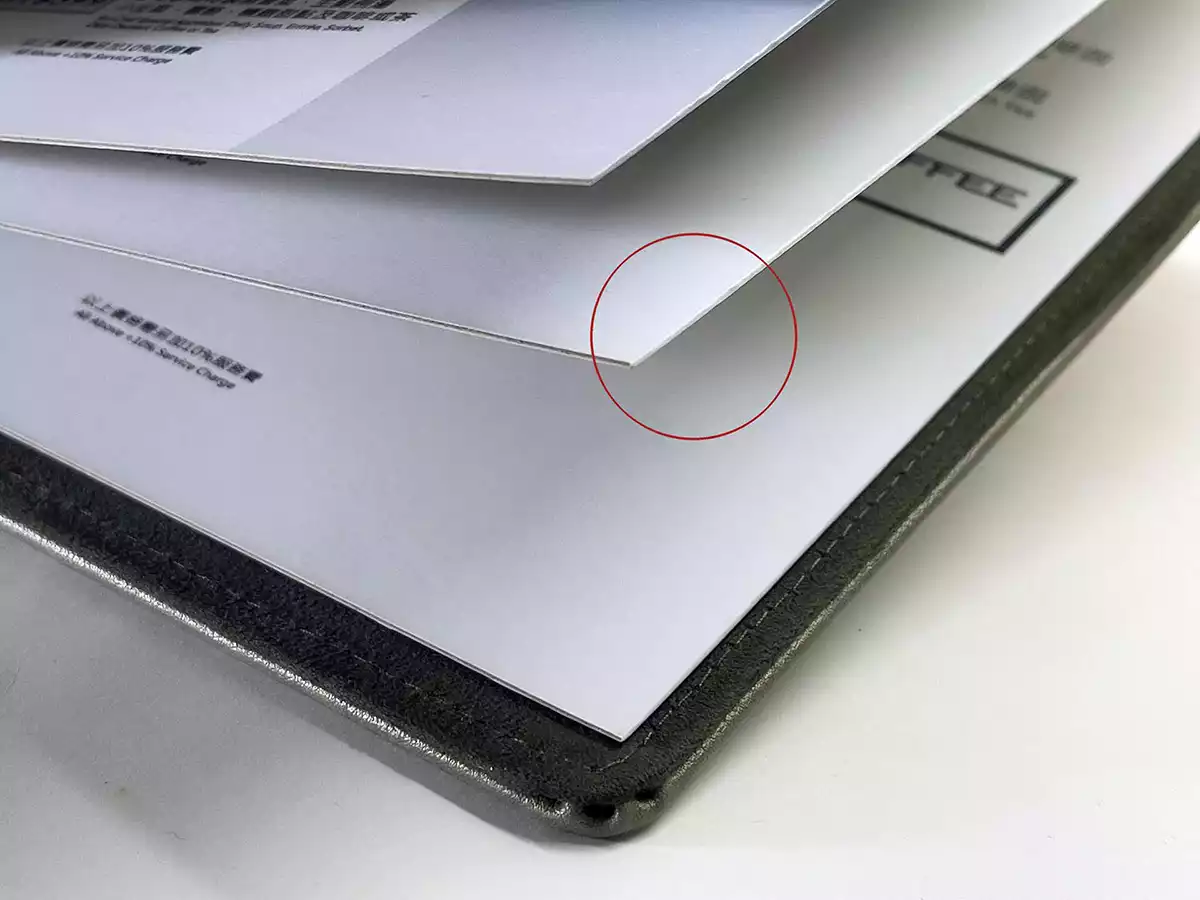
Cardboard inner pages
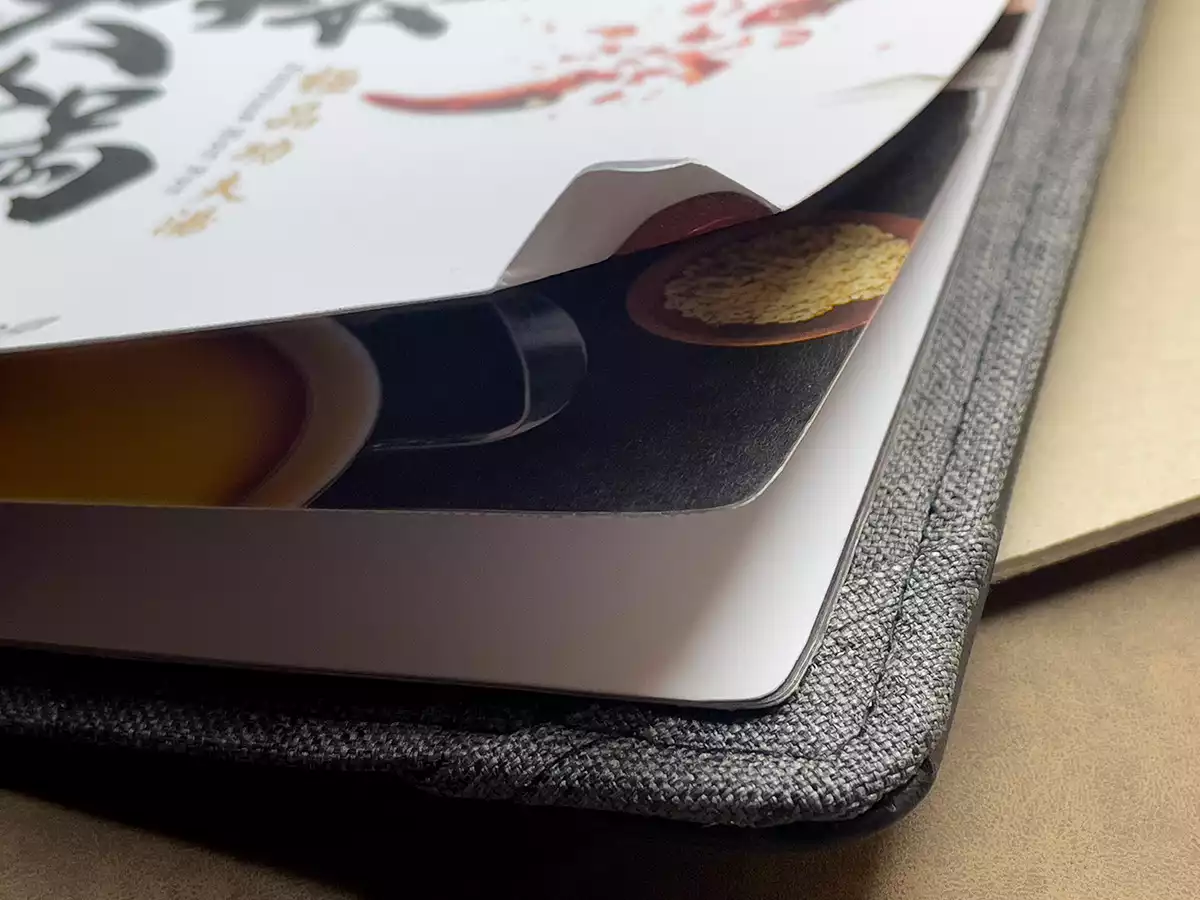
General Sika paper inner page

The information is for verification, please pay attention to the Taiwan service time difference
Weekday service hours:
Morning AM09:00~12:00 Afternoon PM01:30~06:00
Please make an appointment for a visit

No.183, Yongle St., Xinzhuang Dist., New Taipei City 24245, (ROC)
Formosa Taiwan
TEL:+886 2 2279-5252

MEMU™ Facebook page
It may take 36 hours to reply due to Taiwan time difference, Facebook fan page does not have online transaction function, Do not provide quotation or anything about money, Only for technical assistance or answer questions after transaction.

LINE Official Account
You can contact us through LINE app, it may take 36 hours to reply due to Taiwan time difference, LINE has MEMU store, welcome to visit and buy, directly click or scan QR Code with LINE app on your phone to enter the conversation.

LINE Shopping Mall
MEMU™ is the only external LINE shopping mall.
Through LINE Pay / E.SUN Bank payment gateway.
Enjoy online credit card payments and online credit card installment services.

HAPPY BUY™
In-house online quoting service - Happy Buy™.
Online quoting only, no online transaction capabilities.
Both buyers and sellers need to transact through a bank.
